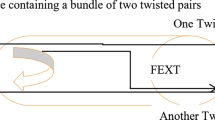Abstract
This paper presents a new technique for reducing the ‘Near–Far’ problem with modified iterative water filling (IWF) algorithm by using the adaptive power spectral mask yielding improved data rate of near end users in a VDSL network. It is shown through graphical results that the proposed technique for spectrum management achieves a significant gain in data rate for ten users VDSL network compared to that of traditional IWF algorithm. However, data rate of the proposed algorithm approaches near to highly complex optimal spectrum balancing (OSB) algorithm. The complexity of the proposed algorithm is same as that of IWF algorithm, which is much lower than that of highly complex OSB algorithm.








Similar content being viewed by others
References
Jacobsen, K. S. (2001). Methods of upstream power back off on very high speed digital subscriber lines. IEEE Communication Magazine, 39, 210–216.
Cherubini, G. (2001). Optimum upstream power back off and multiuser detection for VDSL. In Proceedings of IEEE global telecommunication conference (pp. 375–380).
Schelstraete, S. (2002). Defining upstream power back off for VDSL. IEEE Journal on Selected Areas in Communication, 20(5), 1064–1074.
Zou, H., Chowdhery, A., & Cioffi, J. M. (2009 November). A centralized multi-level water-filling algorithm for dynamic spectrum management. In Conference record of the forty-third Asilomar conference on signals, systems and computers, CA, USA (pp. 1101–1105).
Chen, M. Y., Rhee, W., Mohseni, M., & Cioffi, J. M. (2011). Practical crosstalk management for upstream VDSL using dynamic power control. In Proceedings of IEEE GLOBECOM (pp. 1–5).
Song, K. B., Chung, S. T., Ginis, G., & Cioffi, J. M. (2002). Dynamic spectrum management for next generation DSL systems. IEEE Communication Magazine, 40(10), 101–109.
Yu, W., Ginis, G., & Cioffi, J. M. (2002). distributed multiuser power control for digital subscriber lines. IEEE Journal on Selected Areas in Communication, 20(5), 1105–1114.
Forouzan, A. R., Moonen, M., Maes, J., & Guenach, M. (2011). Joint level 2 and 3 dynamic spectrum management for upstream VDSL. IEEE Transactions on Communications, 59(10), 2851–2861.
Chen, M. Y., Rhee, W., Mohseni, M., & Cioffi, J. M. (2012). Distributed crosstalk management for upstream VDSL using dynamic power control. IEEE Transactions on Communications, 60(4), 940–945.
Liu, Y. S., & Su, Z. S. (2007). Distributed dynamic spectrum management for digital subscriber lines. IEICE Transactions on Communication, E90-B, 491–498.
Tsiaflakis, P., Diehl, M., & Moonen, M. (2008). Distributed spectrum management algorithms for multiuser DSL networks. IEEE Transactions on Signal Processing, 56(10), 4825–4843.
Noam, Y., & Leshem, A. (2009). Iterative power pricing for distributed spectrum coordination in DSL. IEEE Transactions on Communications, 57(4), 1–6.
Huberman, S., Leung, C., & Le-Ngoc, T. (2012). Dynamic spectrum management (DSM) algorithms for multi user xDSL. IEEE Communications on Surveys and Tutorials, 14(1), 110–130.
Cendrillon, R., & Moonen, M. (2005, May). Iterative spectrum balancing for digital subscriber lines. In Proceedings of IEEE international conference on communications, Seoul, Korea (Vol. 3, pp. 1937–1941).
Cendrillon, R., Moonen, M., Verlinden, J., & Bostoen, T. (2006). Optimal multiuser spectrum balancing for digital subscriber lines. IEEE Transactions on Communications, 54(5), 922–933.
Moraes, R. B., Dortschy, B., Klautau, A., & Riu, J. R. I. (2010). Semibind spectrum balancing for DSL. IEEE Transactions on Signal Processing, 58(7), 3717–3727.
Leung, C., Huberman, S., & Le-Ngoc, T. (2010, December). Autonomous spectrum balancing using multiple reference lines for digital subscriber lines. In Proceedings of IEEE global telecommunication conference.
Forouzan, A., & Garth, L. (2005, November). Generalized iterative spectrum balancing and grouped vectoring for maximal throughput of digital subscriber lines. In Proceedings of IEEE global telecommunication conference (Vol. 4, pp. 2359–2363).
Wolkerstorfer, M., Statovci, D., & Nordstrom, T. (2010). Robust spectrum management for DMT based systems. IEEE Transactions on Signal Processing, 58(6), 3238–3250.
Papandriopoulos, J., & Evans, J. S. (2009). Scale: A low complexity distributed protocols for spectrum balancing in multi user DSL networks. IEEE Transactions on Information Theory, 55(8), 3711–3724.
ETSI TS 101 270-1 v1.3.1 Standard. Part 1: Functional requirements, 2003-07.
Mehmood, H., Kerpez, K., & Cioffi, J. M. (2013). Enhanced upstream power back-off for VDSL lines. In Selected areas in communications symposium, IEEE ICC.
Specification of the access network frequency plan applicable to transmission systems connected to the BT access network, UK NICC ND 1602 (2011-09).
Liu, Ya-Feng. (2017). Dynamic spectrum management: A complete complexity characterization. IEEE Transactions on Information Theory, 63(1), 392–403.
Cioffi, J. M., et al. (2018). Terabit DSLs. IEEE Communication Magazine, 56(11), 152–159.
Bai, T., Zhang, H., Xu, C., Rawi, A., & Hanzo, L. (2019). Impulsive noise mitigation in digital subscriber lines: The state-of-the-art and research opportunities. IEEE Communication Magazine. https://doi.org/10.1109/MCOM.2019.1800858.
Author information
Authors and Affiliations
Corresponding author
Additional information
Publisher's Note
Springer Nature remains neutral with regard to jurisdictional claims in published maps and institutional affiliations.
Rights and permissions
About this article
Cite this article
Sharma, S., Sahu, O.P. Reducing Near–Far Problem in a VDSL Network with Modified IWF Algorithm by Using Adaptive Spectral Mask Yielding Improved Data Rate of Near End Users. Wireless Pers Commun 109, 111–125 (2019). https://doi.org/10.1007/s11277-019-06553-1
Published:
Issue Date:
DOI: https://doi.org/10.1007/s11277-019-06553-1




